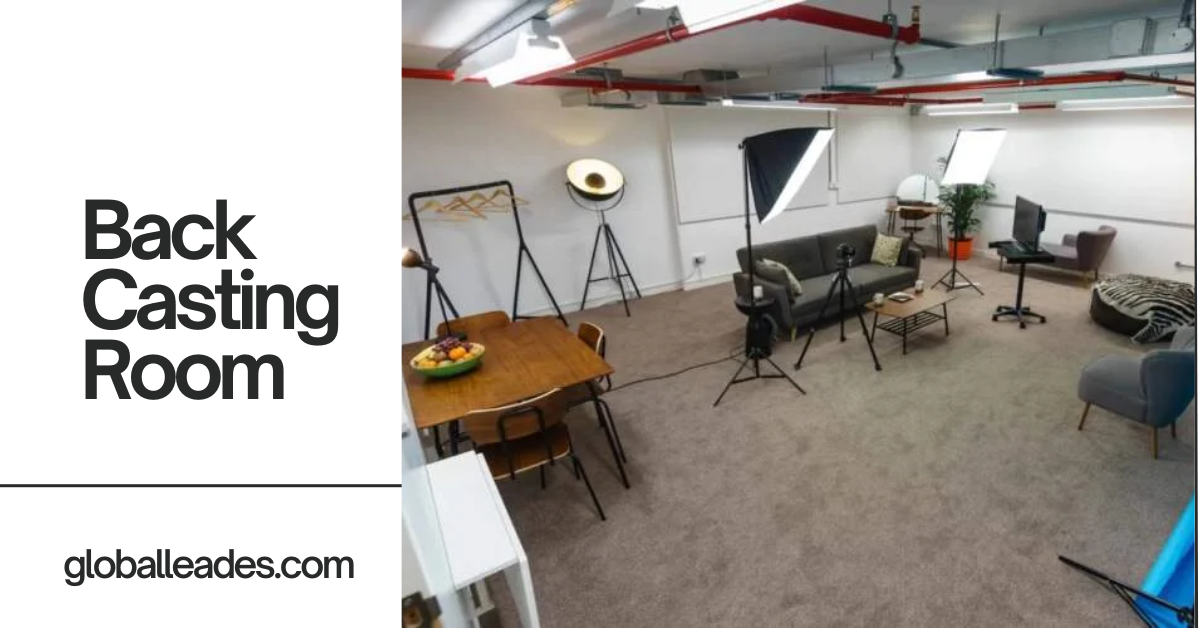In today’s fast-paced and ever-changing world, strategic planning and creative thinking are crucial for success. One innovative approach gaining popularity is the Back Casting Room.
This article delves into the concept of Back Casting Rooms, their features, purpose, and benefits.
We’ll also explore how to set up and design an effective Back Casting Room, common challenges, and real-world applications.
What is a Back Casting Room?
A Back Casting Room is a dedicated space for strategic planning, creative thinking, and problem-solving. It’s a physical environment designed to facilitate collaboration, innovation, and visioning.
Back Casting Rooms are used by businesses, governments, and organizations to develop future scenarios, identify opportunities, and create action plans.
The Origins of Back Casting Rooms
The origins of Back Casting Rooms can be traced back to the strategic planning methodology of backcasting, which was first introduced in the 1990s.
Also Read: Little_Mermaidd0 – Guide to Travel, Fashion, and Fantasies
This approach involves envisioning a desired future and working backward to determine the necessary steps to achieve it. The concept gained popularity in the early 2000s, as organizations sought innovative ways to stay ahead in a rapidly changing world.
As the methodology evolved, the need for dedicated physical spaces to facilitate backcasting sessions became apparent.
Thus, the first Back Casting Rooms were born, designed to provide a collaborative and creative environment for teams to develop future scenarios, identify opportunities, and create action plans.
Since then, Back Casting Rooms have become an essential tool for forward-thinking organizations, governments, and institutions, helping them navigate uncertainty and shape their future with confidence.
Key Features of a Back Casting Room
A well-designed Back Casting Room typically includes:
- Collaborative Space
A large, open area where teams can work together, share ideas, and collaborate on projects.
- Writable Walls
Whiteboards or glass walls that allow team members to brainstorm, mind map, and sketch out ideas.
- Comfortable Seating
Flexible and comfortable furniture that encourages creativity, relaxation, and productivity.
- Minimal Distractions
A quiet and private space with minimal distractions, allowing teams to focus on their work.
- Technology Integration
State-of-the-art technology, such as:
- Virtual whiteboards
- Video conferencing tools
- Collaboration software
- Flexible Layout
A modular design that allows the space to be reconfigured to suit different needs and activities.
- Natural Light
Ample natural light to boost mood, energy, and creativity.
- Acoustic Design
Soundproofing and acoustic design to minimize echo and ensure clear communication.
Also Read: Rssawee – Boost Business Efficiency In 2024
- Inspiring Decor
A visually stimulating environment that inspires creativity and innovation, including:
- Colorful artwork
- Innovative lighting
- Unique furniture designs
These key features combine to create a dynamic and effective space for backcasting, strategic planning, and creative problem-solving.
The Purpose of a Back Casting Room
The primary purpose of a Back Casting Room is to facilitate strategic planning, creative thinking, and problem-solving. It provides a dedicated space for teams to:
Develop Future Scenarios
Envision and create scenarios of potential future states, trends, and outcomes.
Identify Opportunities and Challenges
Analyze scenarios to identify opportunities, challenges, and potential implications.
Create Action Plans
Develop strategic plans and action steps to achieve desired outcomes and mitigate potential risks.
Foster Collaboration and Innovation
Encourage creative thinking, collaboration, and innovation among team members.
Enhance Strategic Planning
Support strategic planning, decision-making, and problem-solving processes.
Facilitate Effective Communication
Enable effective communication, idea-sharing, and feedback among team members.
Support Visioning and Goal-Setting
Help teams define and align their vision, mission, and goals.
Setting Up Your Own Back Casting Room
Setting up your own Back Casting Room requires careful consideration of several key factors. First, identify a suitable location that is quiet, private, and easily accessible.
Next, design the space to facilitate collaboration and creativity, incorporating elements such as writable walls, comfortable seating, and minimal distractions. Technology integration is also crucial, including virtual whiteboards, video conferencing tools, and collaboration software.
Also Read: Autobà – Exploring The Moth Genus Erected by Francis Walker In 2024
Additionally, consider the room’s acoustics and invest in soundproofing and acoustic design to ensure clear communication. Finally, add inspiring decor and flexible furniture to create a dynamic and innovative environment.
By carefully planning and setting up your Back Casting Room, you’ll be well on your way to unlocking the full potential of this powerful strategic planning tool.
Designing a Back Casting Room
Designing a Back Casting Room requires a thoughtful and intentional approach to create a space that fosters creativity, collaboration, and innovation.
Here are some key considerations:
- Natural Light: Incorporate ample natural light to boost mood and energy.
- Flexible Layout: Design a modular space that can be reconfigured to suit different needs and activities.
- Writable Walls: Incorporate whiteboards or glass walls for brainstorming and idea-sharing.
- Comfortable Seating: Choose flexible and comfortable furniture that encourages relaxation and creativity.
- Minimal Distractions: Minimize distractions with soundproofing, acoustic design, and a quiet atmosphere.
- Technology Integration: Incorporate state-of-the-art technology, such as virtual whiteboards and collaboration software.
- Inspiring Decor: Add visually stimulating artwork, innovative lighting, and unique furniture designs to inspire creativity.
- Acoustic Design: Ensure clear communication with soundproofing and acoustic design.
- Sustainability: Incorporate eco-friendly materials and sustainable design principles.
Back Casting Room Best Practices
To maximize the effectiveness of a Back Casting Room, several best practices should be followed. First, establish a clear purpose and objective for each session to ensure focus and direction.
Also Read: TheSportsHouse.net Pendridge – Your Ultimate Guide In 2024
Encourage active participation and collaboration among team members, and use visual aids and brainstorming techniques to facilitate idea generation. Designate a facilitator to lead the session and ensure a positive and creative environment.
Use technology integration to enhance the experience and foster connectivity. Emphasize creativity and imagination, and encourage wild and ambitious ideas. Take breaks to refresh and recharge, and prioritize action planning and next steps to ensure implementation.
Finally, evaluate and improve the process continuously, incorporating feedback and lessons learned to optimize future sessions. By following these best practices, teams can unlock the full potential of the Back Casting Room and drive innovation and success.
Common Challenges in Back Casting Rooms
Back Casting Rooms can sometimes encounter challenges that hinder their effectiveness. One common issue is distractions and lack of focus, which can lead to decreased productivity and idea generation.
Another challenge is ineffective facilitation, where the leader fails to encourage participation, manage time, or guide the discussion. Technology issues, such as connectivity problems or poor sound quality, can also disrupt the session.
Additionally, some team members may be hesitant to share their ideas or feel uncomfortable with the creative process, leading to limited participation. Furthermore, the room’s design and layout can be inadequate, lacking necessary tools or comfortable seating.
Finally, the session may not be well-planned, lacking clear objectives or a clear understanding of the backcasting methodology. By recognizing and addressing these challenges, teams can overcome obstacles and maximize the benefits of the Back Casting Room.
How to Overcome Back Casting Room Challenges
Overcoming challenges in Back Casting Rooms requires:
- Effective Facilitation: Train facilitators to encourage participation, manage time, and guide discussions.
- Clear Objectives: Establish clear goals and objectives for each session.
- Comfortable Environment: Ensure a comfortable and conducive physical space.
- Technology Checks: Conduct thorough technology checks before sessions.
- Encourage Participation: Foster a culture of psychological safety and encouragement.
- Training and Support: Provide training and support for team members and facilitators.
- Flexibility and Adaptability: Be flexible and adaptable when faced with unexpected challenges.
- Continuous Evaluation: Regularly evaluate and improve the Back Casting Room process.
- Team Building: Build trust and rapport among team members through team-building activities.
- Celebrate Successes: Celebrate successes and progress to keep teams motivated.
Also Read: Spicyrranny – Guideline The Fusion of Flavors In 2024
Benefits of a Well-Designed Back Casting Room
A well-designed Back Casting Room offers numerous benefits, including:
- Enhanced Collaboration: Encourages teamwork, creativity, and innovation.
- Improved Problem-Solving: Fosters effective problem-solving and decision-making.
- Increased Productivity: Boosts productivity and efficiency through focused brainstorming.
- Enhanced Creativity: Inspires wild and ambitious ideas through a supportive environment.
- Better Communication: Facilitates open and effective communication among team members.
- Strategic Planning: Supports strategic planning and visioning for future success.
- Innovation and Entrepreneurship: Encourages innovation, entrepreneurship, and out-of-the-box thinking.
- Employee Engagement: Fosters employee engagement, motivation, and job satisfaction.
- Competitive Advantage: Provides a unique and innovative approach to strategic planning, setting organizations apart from competitors.
Real-World Applications of Back Casting Rooms
Back Casting Rooms have numerous real-world applications across various industries, including:
Corporate Strategy
Back Casting Rooms are used by corporations to develop strategic plans, envision future scenarios, and identify opportunities for growth and innovation. This approach helps companies stay ahead of the competition and achieve their goals.
Entrepreneurship
Entrepreneurs utilize Back Casting Rooms to brainstorm business ideas, create business plans, and develop innovative solutions to real-world problems. This approach fosters creativity, innovation, and entrepreneurship.
Government and Public Policy
Governments and public policy organizations use Back Casting Rooms to develop future scenarios, anticipate potential challenges, and create strategic plans to address societal issues. This approach enables proactive governance and informed decision-making.
Also Read: Kääntäminen – Understanding the Basics of Translation In 2024
Education and Research
Educational institutions and research organizations leverage Back Casting Rooms to develop innovative curricula, envision future educational scenarios, and create strategic plans for research and development. This approach fosters innovation, creativity, and academic excellence.
Healthcare
Healthcare organizations use Back Casting Rooms to develop future scenarios for healthcare delivery, anticipate potential challenges, and create strategic plans to improve patient outcomes. This approach enables proactive healthcare management and innovation.
Sustainability and Environment
Back Casting Rooms are used by organizations focused on sustainability and environmental issues to develop future scenarios, identify opportunities for sustainable growth, and create strategic plans to address environmental challenges. This approach fosters sustainable development and environmental stewardship.
Case Studies: Successful Back Casting Rooms
Several organizations have successfully implemented Back Casting Rooms, including:
- Google’s famous “20% time” rooms
- IBM’s Innovation Centers
- The Pentagon’s Strategic Planning Facility
Comparing Back Casting Rooms with Other Recording Spaces
Back Casting Rooms differ significantly from traditional recording spaces, such as conference rooms or meeting rooms.
While traditional spaces are often designed for straightforward communication and information sharing, Back Casting Rooms are specifically designed to facilitate creative problem-solving, strategic planning, and innovation.
Also Read: How to Incorporate Geöe into Your Life In 2024
Unlike traditional spaces, Back Casting Rooms incorporate writable walls, flexible furniture, and advanced technology to support collaborative brainstorming and idea generation.
Additionally, Back Casting Rooms are designed to be distraction-free, comfortable, and visually stimulating, creating an environment that fosters creativity and imagination.
In contrast, traditional recording spaces often lack these features, making them less effective for creative problem-solving and strategic planning.
By providing a unique and supportive environment, Back Casting Rooms enable teams to think outside the box, challenge assumptions, and develop innovative solutions.
Future Trends in Back Casting Room Design
The future of Back Casting Room design is poised to revolutionize the way teams collaborate and strategize. Advanced data analytics will uncover hidden patterns and drivers, while virtual reality integration will create immersive scenario-building experiences.
Artificial intelligence will provide predictive insights and automate data analysis, freeing teams to focus on high-level thinking. Modular design will allow for easy reconfiguration, adapting to the needs of each project.
Sustainable materials will become the norm, aligning with the growing importance of environmental sustainability. Enhanced collaboration tools, such as virtual whiteboards and real-time feedback, will facilitate seamless communication.
Also Read: превоодач – Mastering the Art of Translation
Finally, dynamic scenario planning will enable organizations to respond agilely to changing circumstances, updating scenarios in real-time. These trends will transform Back Casting Rooms into cutting-edge hubs for innovation and strategic planning.
Conclusion
In conclusion, Back Casting Rooms are a powerful tool for strategic planning, innovation, and problem-solving. By understanding the concept, benefits, and best practices of Back Casting Rooms, organizations can unlock their full potential and drive success.
From corporate strategy to sustainability and environmental issues, the applications of Back Casting Rooms are vast and varied. By staying ahead of the curve and incorporating future trends in design, organizations can create cutting-edge spaces that foster creativity, collaboration, and innovation.
Whether you’re a business leader, entrepreneur, or innovator, Back Casting Rooms are an essential tool to help you achieve your goals and shape the future.
FAQs
What is the ideal size of a Back Casting Room?
A Back Casting Room can accommodate 5-20 people, depending on the organization’s needs. The room should be large enough to facilitate collaboration but small enough to encourage active participation.
How often should a Back Casting Room be used?
A Back Casting Room should be used regularly, ideally once a quarter, to stay ahead of the curve and address emerging challenges. Regular use helps teams stay focused and aligned with the organization’s goals.
Can Back Casting Rooms be used for personal goal setting?
Yes, Back Casting Rooms can be used for personal goal setting, helping individuals envision their future and create a roadmap to achieve their objectives. This approach helps individuals clarify their priorities and stay focused on what’s important.
How do I ensure confidentiality in a Back Casting Room?
Confidentiality is crucial in a Back Casting Room. Ensure that all participants understand the importance of confidentiality and sign non-disclosure agreements if necessary. This creates a safe space for open discussion and idea sharing.
Can I use technology to facilitate remote Back Casting Rooms?
Yes, technology can be used to facilitate remote Back Casting Rooms, enabling global teams to collaborate and strategize effectively. Utilize video conferencing tools, virtual whiteboards, and collaboration software to create an immersive experience.
How do I measure the success of a Back Casting Room session?
Success can be measured by the number of ideas generated, the quality of solutions developed, and the progress made towards achieving strategic objectives. Evaluate the session’s effectiveness and gather feedback to improve future sessions.
Can Back Casting Rooms be used in non-profit organizations?
Yes, Back Casting Rooms can be used in non-profit organizations to develop strategic plans, envision future scenarios, and address social and environmental challenges. This approach helps non-profits stay focused on their mission and achieve greater impact.




